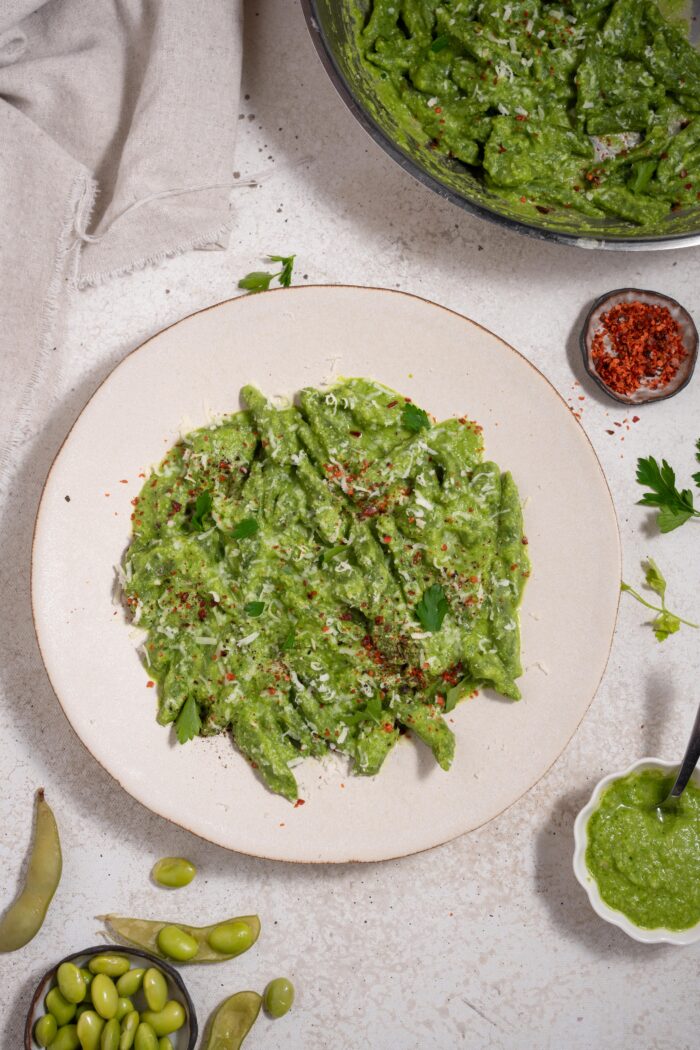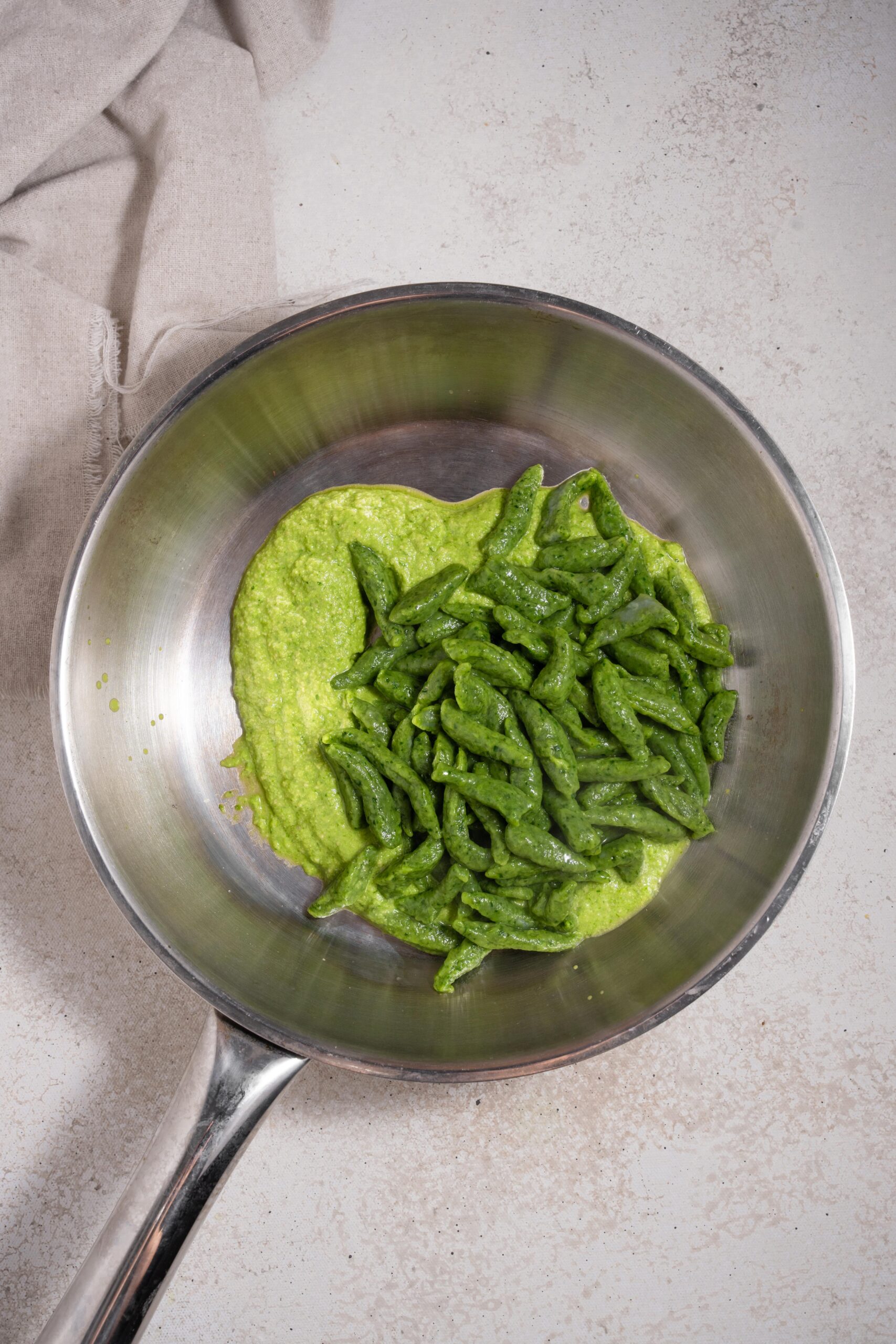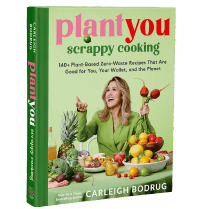Homemade Green Pasta
There is a huge advantage in being able to make things from scratch, like this homemade green pasta. As always, I made it as easy and fun as possible!

The idea of making pasta from scratch might seem daunting, but it is surprisingly simple. And before anyone asks, NO you do NOT need to use egg to make fresh pasta.
This homemade green pasta is further fortified by spinach and kale, which is a great way to eat more veggies and use up leftover herbs and greens in your fridge.
In my household, food never goes to waste! If that sounds like a philosophy you want to get on board with, PREORDER SCRAPPY COOKBOOK NOW. The upcoming book features over 150 delicious vegan recipes with the signature PlantYou infographics.
The twist? These new recipes are aimed at helping you reduce food waste, make the most of your produce, and raid your kitchen when you’re out of ideas. Submit your purchase receipt and get access to $200+ worth of digital freebies as a personal thank you from me!
Why You’ll Love This Recipe
- If you’ve toyed with the idea of making homemade pasta before, this is the perfect first recipe to try it out. It’s so simple, you’ll be making fresh pasta all the time!
- This homemade green pasta gets its color from kale and spinach. What an awesome way to get more nutrients into your diet! Better yet, you can use whatever greens and herbs you have access to.
- Not only is this recipe vegan (therefore egg-free and dairy-free), it is also entirely made with whole-food ingredients. If you want to have control over what goes into your body, cooking from scratch is the way to go!
- The sauce is just as simple as the pasta itself. Of course, you can also serve the homemade green pasta with the sauce of your choice.
- The process of making the noodles is uber fun! If you are learning to cook, this is a great recipe to engage with the food. And of course, this is a perfect family-friendly activity to share with your kids.


Brief History of Pasta
The history of pasta spans centuries, with origins dating back to ancient civilizations. While the true origins of pasta are debated, it is commonly associated with Italy. Historical records suggest that ancient Etruscans and Romans consumed a form of pasta, likely made from a mixture of water and wheat.
The Arab influence in medieval Sicily is thought to have played a significant role in introducing dried pasta to Italy, as it provided a practical and durable food source. By the 13th century, references to pasta dishes had become more prominent in Italian literature.
Some varieties incorporate vegetables and other natural ingredients to enhance both visual appeal and flavor. For instance, spinach is often used to produce green-hued pasta, beetroot for a reddish tint, and squid ink for a distinctive black color.
The other wonderful signature quality of pasta is the variety of shapes it comes in. Even when making fresh pasta, you can shape it into anything from long spaghetti noodles and lasagna sheets to gnocchi and ravioli dumplings.


Hand Shaping vs. Pasta Maker
The choice between hand-shaping pasta and using a pasta machine depends on personal preference, time constraints, and the desired outcome.
- Hand-shaping pasta allows for a more artisanal and rustic appearance. The irregularities and imperfections can add charm and character to the pasta. Conversely, a pasta machine ensures uniform thickness and shape, resulting in a more consistent texture and appearance across the entire batch of pasta.
- With hand-shaping, you have direct control over the thickness of the pasta. You can feel and adjust the thickness as you go, which can be advantageous for specific pasta types. Most pasta machines have adjustable settings for thickness, allowing you to achieve specific thickness levels with precision.
- Hand-shaping is the traditional way of making pasta, and it can be a rewarding experience for those who enjoy the tactile and hands-on aspect of cooking.
- Hand-shaping doesn’t require any specialized equipment, making it accessible to those who may not have a pasta machine.
- Using a pasta machine is generally faster and more efficient, especially when making large quantities of pasta. It streamlines the rolling and cutting process.
In summary, hand-shaping pasta offers a more traditional and hands-on approach, allowing for a rustic appearance and a deeper connection to the cooking process. On the other hand, a pasta machine provides efficiency, consistency, and versatility, making it a preferred choice for those who prioritize convenience and precision in pasta making.

How to Make This Recipe
This recipe comes with an optional sauce. If you’re planning to serve your homemade green pasta with this creamy edamame sauce, you’ll need to make it first.
The good news is, it’s super simple. You just need to blend all of the green sauce ingredients in a high-speed blender.


Alternatively, you can serve this pasta with store-bought sauce, a serving of chili, or a different homemade recipe, like this vegan bolognese.
Time for the main event! To make the pasta dough, use a food processor to combine the flour with greens and olive oil. Processing it should be enough for a dough ball to form. If in doubt, add a tiny bit more oil.


Dust a clean kitchen surface with flour and empty the contents of the food processor onto the counter. Knead your green pasta dough for a couple of minutes, shaping it into a flat disk.
Boil water in a large pot with a pinch of salt. Using scissors or a pizza cutter, slice your dough into approximately 1-inch long “noodles”.


Fresh pasta cooks much faster, so you’ll only need to leave it to boil for 4-5 minutes until soft.


Transfer the homemade green pasta to a pan, along with the sauce of your choice. Toss everything together over medium heat and serve immediately with freshly cracked black pepper, red chili flakes, and vegan parm as desired.


Hack It!
- For the pasta dough, you can use whatever greens or herbs you have available to you. I used spinach and kale, but you can also use parsley, basil, or any combination of the above.
- For a soy-free sauce, sub edamame for green peas or canned (drained) white beans.
- If you have a nut allergy, use raw sunflower seeds instead of cashews for the sauce. Even if you have a high-speed blender, it helps to soak the seeds in advance for a nice creamy texture.
- I am not versed in making gluten-free pasta from scratch, but you can still enjoy the sauce with store-bought chickpea or rice noodles.
- You can also do the reverse. Feel free to enjoy this homemade green pasta with a different sauce.



Other Recipes You’ll Love
- One Pot Green Pasta
- Easy Lemon Garlic Pasta
- Vegan Marry Me Pasta
- Zucchini Lemon Pasta
- Pink Beet Pasta Sauce
If you’re an adventurous cook who likes to try new recipes every week, you’ll love the PlantYou Planner! It’s an interactive meal planner app that’s fully vegan and largely WFPB. You get to choose from over 600 delicious recipes to create your own meal plan, or follow one of the plans curated by our team. In addition to all that, the app provides allergy swaps for most recipes and generates a custom shopping list. How amazing is that?
Just because you’re eating plenty of fruit and veggies, doesn’t always mean your nutritional criteria is met. I have recently collaborated with an amazing women-led supplement company to create a multinutrient aimed at plant-based and plant-centered eaters. With Complement x PlantYou Essential, thriving on a vegan diet has never been easier!

The Recipe: Homemade Green Pasta
Ingredients
- 1 cup all-purpose flour, or pasta flour
- 4 cups greens, I used spinach and kale
- 2 tbsp extra virgin olive oil
For the sauce (optional)
- 1 handful greens, heaping, I used parsley
- 1 clove garlic
- ½ cup water
- 2 tbsp cashews, or sunflowers seeds
- ½ cup edamame, thawed
Equipment
- High-speed blender if making the sauce
- Scissors
Instructions
- If making your sauce, prepare it first. In a blender, add the greens, garlic, water, cashews and edamame, and blend until smooth.
- For the pasta, in a food processor, add the flour, greens and oil. Process until you achieve a “dough ball”.
- Transfer to a floured surface, and knead for a couple of minutes, forming into a flat disk shape.
- Bring a large pot of water to a boil, then using scissors, slice the disk into approximately 1 inch long “noodles”. Transfer to the boiling water, and cook for 4 to 5 minutes, until soft.
- Once cooked, transfer to a pan over medium heat with the sauce. Combine everything and then serve with black pepper, red chili flakes and vegan parm as desired.

